To dress for a Filipino wedding as a foreign guest, embrace traditional attire like the Barong Tagalog for men or the Maria Clara gown for women. If that’s too formal, opt for a smart suit or elegant semi-formal dress. Avoid white or red to respect the bride. Don’t forget to accessorize with culturally significant pieces like capiz shell jewelry. Arriving on time and participating in traditions are key. There’s more to contemplate, so keep exploring your options!
Key Takeaways
- Opt for traditional Filipino attire like the Barong Tagalog for men or a Maria Clara gown for women to honor cultural heritage.
- Avoid wearing white or red to respect the bride and traditional wedding customs.
- Check the invitation for specific dress codes, such as formal or semi-formal attire requirements.
- Accessorize with culturally significant items like Capiz shell jewelry or a Terno-inspired clutch to complement your outfit.
- Arrive on time and participate in wedding traditions to show respect and appreciation for the couple and their families.
Understanding Filipino Wedding Attire
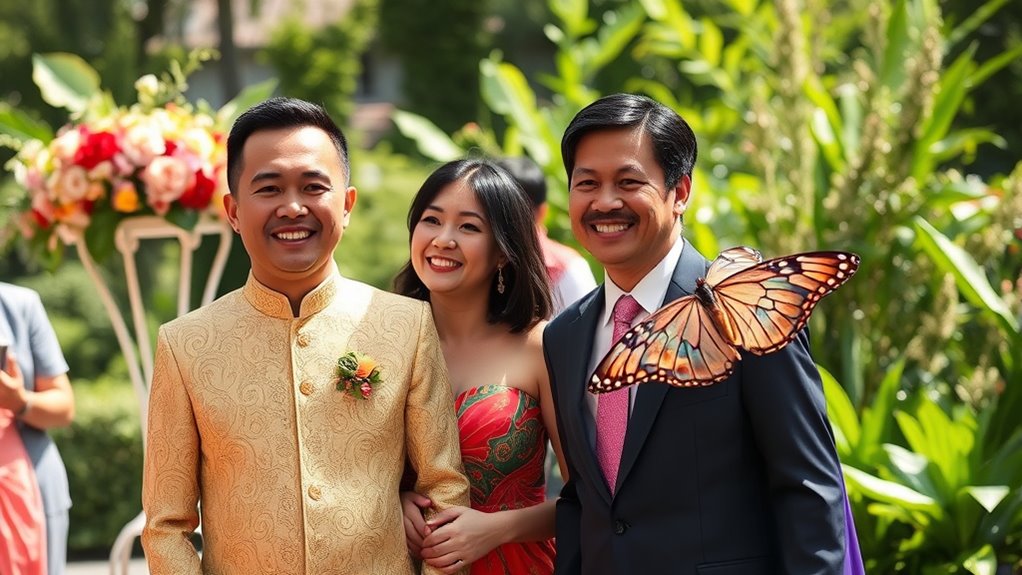
When you attend a Filipino wedding, understanding the significance of traditional attire is essential. The Barong Tagalog for men, an embroidered long-sleeved shirt worn over a plain white shirt, showcases cultural pride.
For women, the Maria Clara gown blends Filipino and Spanish influences, while the Terno, with its iconic butterfly sleeves, is another classic choice. Guests are encouraged to dress conservatively, reflecting respect for the couple and their background.
Embracing cultural dress codes, such as Filipiniana, not only honors tradition but also enhances the festive atmosphere. Wearing traditional accessories and modest jewelry can beautifully complement your outfit, allowing you to participate fully in this vibrant celebration and demonstrating your appreciation for Filipino heritage.
Traditional vs. Formal Attire
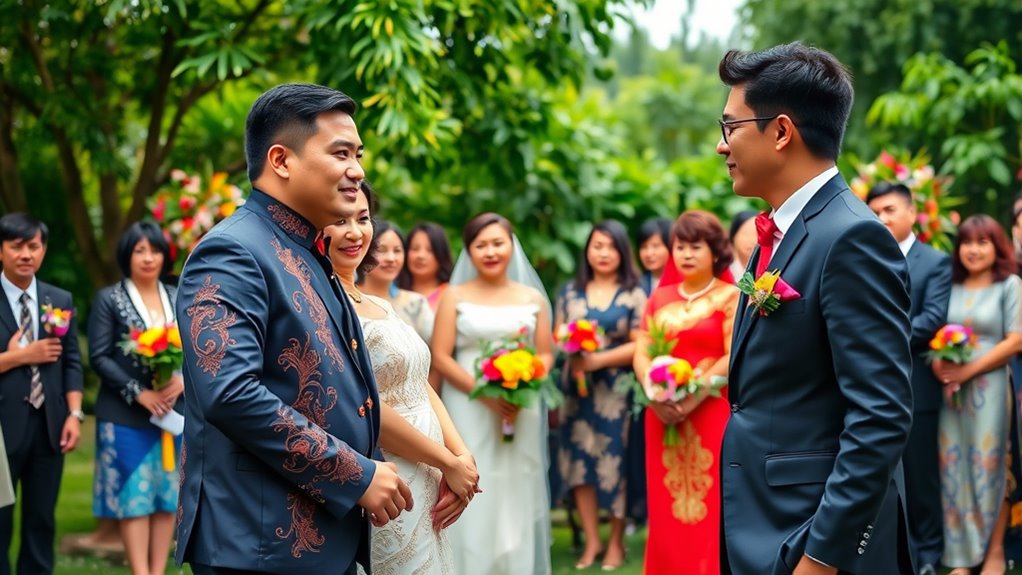
While both traditional and formal attire can be appropriate for a Filipino wedding, understanding the nuances between the two will help you make the right choice.
Traditional attire like the Barong Tagalog for men and the Baro’t Saya or Maria Clara gown for women holds significant cultural meaning, showcasing Filipino heritage. Wearing these outfits signals respect for the culture and the ceremony.
Traditional attire, such as the Barong Tagalog and Baro’t Saya, embodies Filipino heritage and signifies respect for the culture and ceremony.
On the other hand, formal attire, such as suits for men and semi-formal dresses for women, offers a modern approach that’s still elegant. Remember to avoid white or red to honor the bride.
Ultimately, your choice should balance comfort, respect for tradition, and the wedding’s overall theme to guarantee you fit right in.
Choosing the Right Outfit for the Dress Code
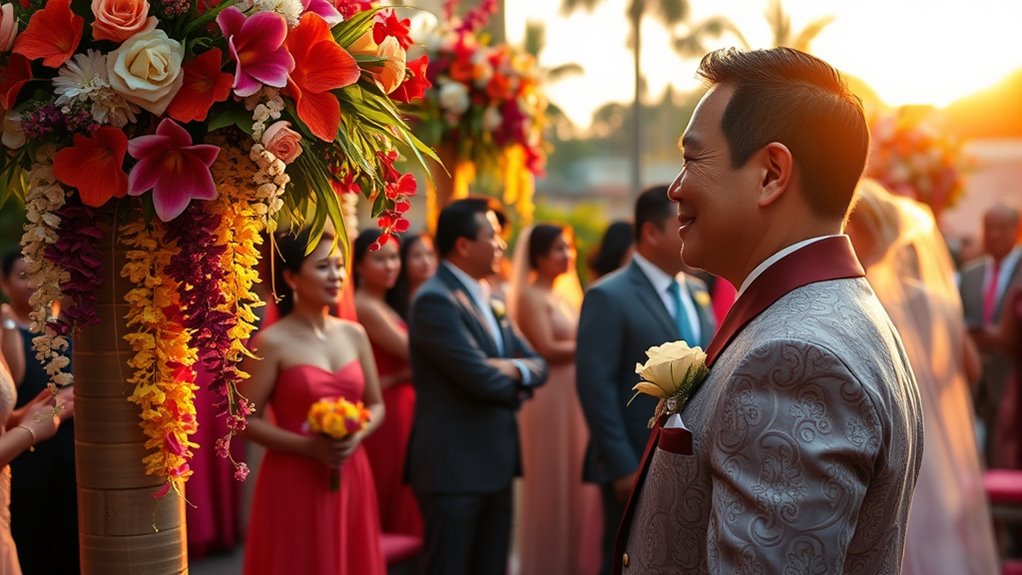
How can you guarantee your outfit aligns with the dress code for a Filipino wedding? Start by identifying the specific dress code mentioned in the invitation.
For a white-tie occasion, opt for a floor-length gown, while a black-tie event allows for formal yet slightly less strict attire.
If it’s a semi-formal or dressy casual gathering, choose smart-casual outfits that reflect your personal style.
Cocktail attire means you can embrace modern and stylish looks, while tropical or beach themes invite lighter, breezier clothing.
Consider the time of day too—brighter colors work for daytime ceremonies, while evening events often call for darker, more formal attire.
Always respect the venue and cultural elements to ascertain you’re appropriately dressed.
Accessories to Complement Your Look
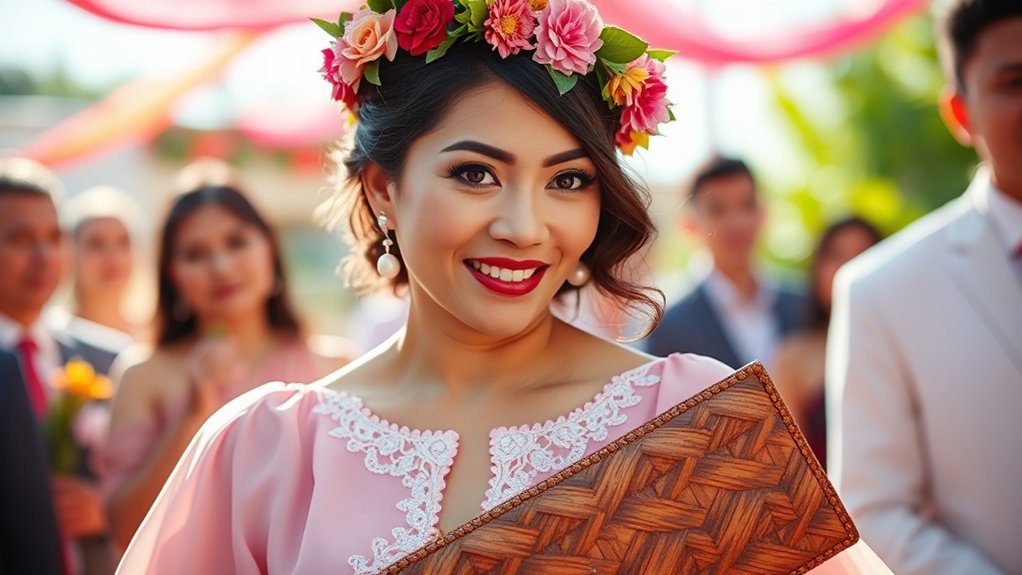
To truly elevate your outfit for a Filipino wedding, don’t overlook the power of accessories. Consider wearing capiz shell jewelry, like earrings or necklaces, which blends elegance with cultural significance.
Adding pearl jewelry not only honors Filipino heritage but also enhances your look’s sophistication. Handmade beaded accessories can bring a beautiful and meaningful touch, while bamboo or rattan items reflect traditional craftsmanship.
A terno-inspired clutch adds a stylish, cultural flair. For practicality and charm, think about including a pamaypay or abaniko fan. Traditional hats can give you that unique flair, and intricately embroidered shawls showcase the rich textile heritage.
Choose accessories that resonate with the beauty and craftsmanship of Filipino culture, and you’ll surely stand out.
Cultural Etiquette and Respectful Practices
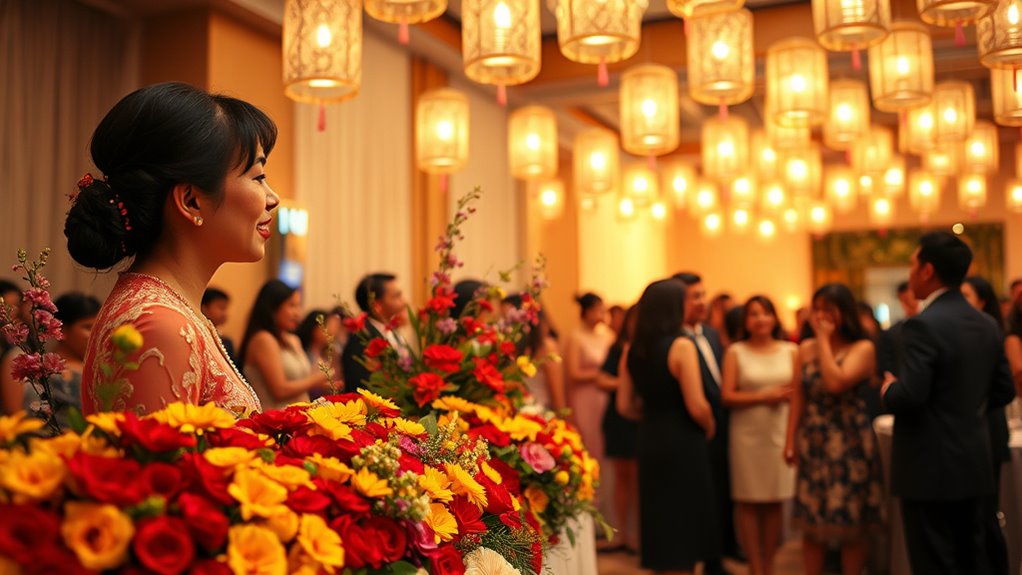
Attending a Filipino wedding requires an understanding of cultural etiquette and respectful practices that honor the significance of the occasion.
Dress conservatively; women should opt for dresses or skirts, while men often wear the Barong Tagalog. It’s essential to arrive on time, greet the couple and their families, and show respect for elders.
Monetary gifts are common, so consider contributing. Participate in traditional customs and be mindful of cultural norms to avoid unintentional offense. Learning basic Tagalog phrases, like “Mabuhay,” can show appreciation.
Monetary gifts are appreciated; embrace traditions and learn a few Tagalog phrases to enhance your experience.
Embrace the opportunity to enjoy traditional foods and songs, and always express gratitude for being part of this special celebration. Your respect and involvement will be greatly appreciated by the hosts.
Frequently Asked Questions
Can I Wear Western-Style Clothing to a Filipino Wedding?
Yes, you can wear Western-style clothing to a Filipino wedding, but it’s often best to lean towards traditional attire.
Many couples appreciate when guests respect their cultural heritage. If the invitation doesn’t specify, you might choose formal Western wear like a suit.
Just remember, blending in traditional elements or accessories can show your respect for the culture while still expressing your personal style.
Always consider the couple’s preferences when deciding your outfit!
What Colors Should I Avoid When Dressing for a Wedding?
When dressing for a wedding, you should avoid colors like white and ivory, as these are traditionally reserved for the bride.
It’s best to steer clear of any shades that might overshadow her, including bright reds or vibrant hues that could draw attention away from the couple.
Instead, opt for neutral tones or softer colors that complement the celebration without competing with the bride’s attire.
Always consider the couple’s preferences and cultural significance, too.
Are There Specific Fabrics Recommended for Tropical Weddings?
Imagine walking through a sun-drenched garden, the gentle breeze rustling your lightweight dress.
For tropical weddings, you’ll want breathable fabrics like chiffon and tulle that flow with you, keeping you cool.
Cotton and linen are perfect for that relaxed vibe, while silk adds a touch of elegance for indoor settings.
Choose fabrics that not only look stunning but also keep you comfortable, allowing you to fully enjoy the celebration.
How Can I Incorporate Filipino Elements Into My Outfit?
To incorporate Filipino elements into your outfit, consider using lightweight fabrics and traditional colors like beige or pastel hues.
Adding embroidered details or butterfly sleeves can give your look a cultural flair. Accessories like traditional jewelry or floral hairpins enhance the theme.
You might also opt for modern pieces inspired by the Barong Tagalog or Terno designs.
Don’t forget to choose comfortable yet stylish shoes to complete your ensemble!
Is It Appropriate to Wear a Hat or Headpiece?
Picture a sun-drenched garden filled with vibrant colors and elegant attire.
When you think about wearing a hat or headpiece, keep in mind that while stylish accessories can enhance your look, they should align with Filipino customs.
Traditional events often lean towards simplicity and elegance. If you choose to wear one, make certain it’s tasteful and doesn’t overshadow the significance of the occasion.
Ultimately, focus on showing respect and celebrating the culture.
Conclusion
As you prepare for a Filipino wedding, think of yourself as a vibrant flower in a lush garden—every detail of your attire contributes to the beauty of the celebration. By choosing the right outfit, respecting cultural norms, and accessorizing thoughtfully, you’ll not only shine but also honor the rich traditions of the couple’s heritage. So, step into that garden with confidence, and let your presence add to the colorful tapestry of love and joy surrounding you.









